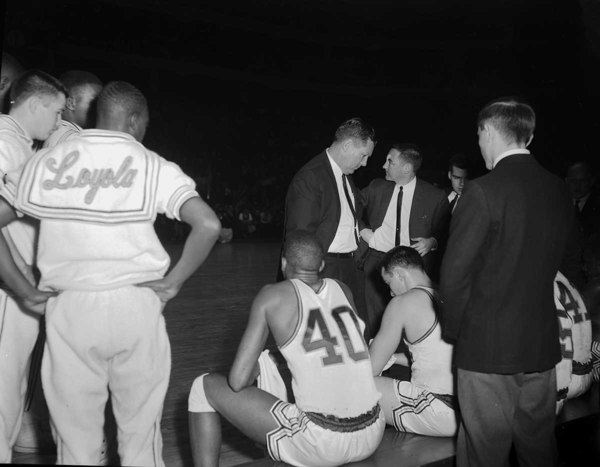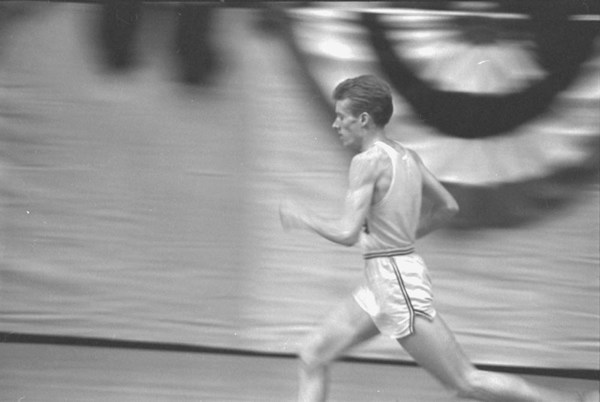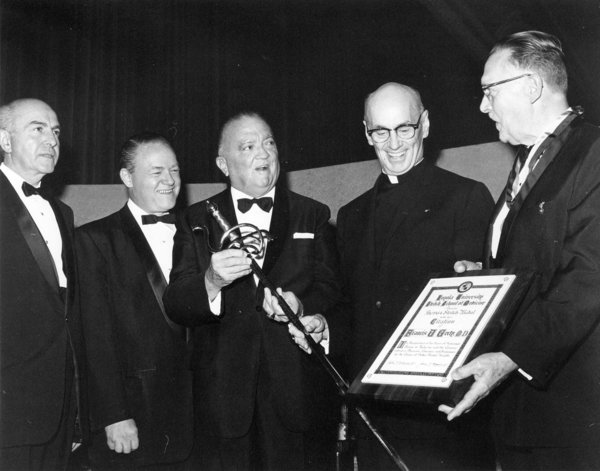Toward Greatness: 1945-1970
The end of World War II and the introduction of the G. I. Bill saw a tremendous influx of students to Loyla University. To prepare for the post-war students, the university created a Veterans' Administration office and set up counseling services to assist the returning veterans in adjusting to the routine of academic life.
Under the leadership of its president, the Rev. James T. Hussey, S.J., Loyola's enrollment rose to 7,000, which represented an increase of 2,000 over the pre-war enrollment figure.
It was under Father Hussey's stewardship, which lasted 10 years, that Loyola began its move toward greatness. The Law School, which had been closed for the duration of the war, was re-opened on the ninth floor of Lewis Towers.
It was during Father Hussey's years that Loyola obtained Lewis Towers, which became the nucleus of the downtown campus. The building was given to the university in 1946 by the late Mr. and Mrs. Frank J. Lewis, a couple famous for their generosity to the cause of independent, higher education. Mr. Lewis was a member of the Board of Lay Trustees.
The 18-story skyscraper, located at 820 Norht Michigan Avenue, across from Chicago's historic Water Tower, enabled the universiy to consolidate its evening school and its schools of commerce, law and social work in one building.
In 1948, the School of Nursing was reorganized in order to unite the departments of nursing, nursing education and public health nursing. That same year saw the formation of the Army Reserve Officers Training Corps (ROTC) on the Lake Shore campus. A year later, the nursing school instituted a four year program.
In 1950, the first Cardinal's dinner was held. The dinner, which was sponsored by the late Samuel Cardinal Stritch after whom the medical school was named, was the forerunner of the Annual Award dinner for the Stritch School of Medicine - the most distinguished philanthropic event of its kind in the country.
Loyola basketball, which had produced great teams during the Leonard Sachs' era, continued to thrive under Coaches Tom Haggerty and George Ireland. Haggerty's Ramblers ended the 1948-49 season by playing in the National Invitational Tournament in New York. In the quarter final, Loyola upset a powerful University of Kentucky team 67-57; Kentucky later that season won the NCAA championship for the second time. Loyola placed second in the N.I.T. tournament after losing to the University of San Francisco 48-47.
George Ireland was named head coach in 1951. He was a star athelete in his playing days at Campion Jesuit High School, Prairie du Chien, Wisconsin, and Notre Dame University. Named Athletic Director at Loyola in 1958, Ireland has spent more than 18 years coaching Rambler basketball teams. His teams have totaled 268 wins against 175 losses for a .605 winning percentage. His Rambler squad won the NCAA Championship in 1963.
In 1955, the Very Rev. James F. Maguire, S.J., became the 20th president of Loyola University.
The building and academic tempo of growth continued throughout the fifties and into the sixties beginning when Campion Hall, a men's residence, was erected on the Lake Shore campus.
A Master of Science curriculum in oral anatomy, later called oral biology, was established as well as masters and doctoral programs in Chemistry, and a master of science program in dental science.
In 1962, Loyola became the first American University to establish a study center in Rome, Italy.
Track star Tom O'Hara in 1964 set the world's record still unbroken for the indoor mile (3:56.4 seconds).
During 1964, the School of Nursing established a graduate program designed to prepare teachers and clinical specialists. Loyola was the first school in the Midwest to offer a nursing program which prepares teachers for junior and community colleges.
Also in that same year, the first Sword of Loyola was awarded at the Annual Award Dinner for the Stritch School of Medicine. Since that time, the award has been given annually to outstanding individuals whose lives have reflected St. Ignatius of Loyola's qualities of "Courage, Dedication and Service".
In 1965, the Bellarmine School of Theology was moved from West Baden, Indiana, to North Aurora, Illinois.
The sixties also resulted in the formation of a Center for Research in Urban Government (CRUG) to train specialists in urban government and to carry out research projects in the complex problems of urban living.
To meet the demands of industry for more highly trained executives, Loyola initiated a Master of Business Administration (MBA) program in 1966. Since its inception, enrollment has soared to over 1,300 students, who come from colleges from all over the country and from many leading firms and corporations.
In 1969, the Department of Education evolved into the School of Education enrolling 940 graduate and 216 undergraduate students.
Facilities contructed since 1962 include Damen Hall, a 10-story science classroom building, and Pere Marquette Center, a combination student union and classroom facility.



